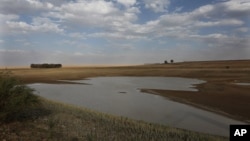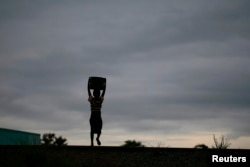Severe food shortages in southern Africa are expected to grow dramatically worse by year's end, unless the world does something soon.
African aid experts say they worry that the continent’s crippling drought may fall behind crises in conflict-ravaged nations like Syria, Yemen, and Iraq, as international aid officials converge this week for the first-ever World Humanitarian Summit in Istanbul.
“The window for responding in a meaningful manner is closing rapidly,” said Shadrack Omol, senior adviser to the United Nations’ children’s emergency fund. “Slow-onset emergencies, such as the one we are dealing with in southern Africa do not get enough attention because they creep up on us.”
The weather pattern that led to the drought — the famously erratic El Nino — has been battering Africa’s east and south since 2015, first drenching parts of the region with severe floods, and then baking it dry with severe drought. The crisis has affected some 32 million people in Southern Africa alone, and experts say they expect new assessments to rise to nearly 50 million people in early June.
“Behind each unit, there is a person,” Elhadj As Sy, secretary general of the International Federation of Red Cross and Red Crescent Societies. “There is a mother who is really having this invisible pain to see your children going to bed hungry, or to hear them cry for food because you cannot satisfy those needs.”
Sy said he’ll be pushing hard for attention at the summit.
“Of course it’s about food,” he said. “Of course it’s about water, of course it’s about sanitation — but it’s also about dignity.”
Harvests were poor in April. That food is expected to tide some people over temporarily, but then the situation could take a turn for the worse by July, “reaching its peak between December 2016 and April 2017,” according to the most recent assessment by the U.N. Office for the Coordination of Humanitarian Affairs.
Malawi hit hard
The head of the International Red Cross and Red Crescent Societies visited two nations — Malawi and Zimbabwe — badly affected by drought. here, he found heartbreaking scenes, such as a determined young man digging for water in a dried-out riverbed.
Malawi is an especially sad example of how vulnerable these countries are to shocks. In just three years, the once-promising agricultural economy has gone from being able to export food to “a state of emergency,” declared by President Peter Mutharika in April.
Malawi saw a 12.4 percent decline in maize production this year, leaving at least 2.8 million people in need of food aid for the rest of this year.
“In most cases we don’t take breakfast, and my children go to school on empty stomach,” said Blantyre resident Alice Matabwa. “We only take lunch and a small portion of dinner at night.”
Ellen Mkawa, a single mother of five, said she gave up on her maize field because of the drought. But she’s struggling to sell maize at the market.
“The aim is find money so that I can buy some food to feed my family,” she said. “But the only problem now is that I don’t have enough capital.”
Even South Africa, the region’s richest and most advanced nation, has suffered.
Andrew Odero, a regional food security analyst for the WFP, said that the nation will now have to import “substantial amounts” of maize for the first time. He said he also expects prices to rise to the unprecedented level of $250 per ton (4,000 rand).
“Looking at the wider macroeconomic context, we also see that in general inflation rates are high, market prices have more than doubled in particular countries,” he said. “I’m quite worried about Malawi, Mozambique, Zimbabwe.”
Four of ten children in Southern Africa were already stunted before this crisis hit, according to U.N. figures.
Odero said what little safety net people had is unraveling.
“From where I sit, I am pretty worried because there has been a lot of disruptions in the season as a result of El Nino, coming on the back of a poor harvest from the previous season,” he said. “So there’s a carryover of production shortfalls from the previous seasons.”
By next March, nearly half of Zimbabwe’s rural population — up to 4.5 million people — will need food aid, according to the U.N. Development Program.
Eddie Rowe, the World Food Program’s country director in Zimbabwe, said the nation’s skewed economy means that it is especially hard hit.
“There are four major livelihood opportunities, and three are agricultural — the fourth is remittances,” he said. “If three of the four major livelihood opportunities are affected by this drought, then what this means is the likelihood of a recovery between now and the next harvest are very, very minimal.”






